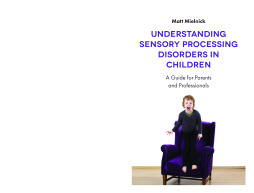
Additional Information
Book Details
Abstract
Everything we know about the world we live in starts with information we take in through the senses. This book explains the way our sensory system works and shows how small inefficiencies in this complex system can have a huge impact on a child's behaviour. Through easily relatable examples and metaphors, the book describes the variety of sensory processing differences that can occur in children in a jargon-free way and offers practical advice to help manage these differences.
It explains how children's varying sensory thresholds - the point where a behavioural response to a stimuli is generated - affects the way they view the world. Each section includes occupational therapy evaluations of children with a range of sensory thresholds, and shows how this influences their behaviour through professional observation reports, offering a summary and recommendation for each child. Presented with a clear focus, without long lists of syndromes and symptoms, this is the ideal starting point for parents and professionals working with children with sensory processing issues.
Matt Mielnick is a Pediatric Occupational Therapist in private practice with 20 years of experience working with young children, providing evaluation and treatment services, in New York and Massachusetts.
The author is a Pediatric Occupational Therapist specializing in working with young children and in this book he aims to provide information that is easy for parents and professionals to understand, rather than an academic publication... Mielnik writes in a style that uses metaphors and images and some extended case studies to illustrate the evaluation process with specific children... A very useful introduction to this field.
Mary Mountstephen
Mr. Mielnick evaluated my son for OT services through the Department of Ed Pre-school program. Throughout that process I was impressed with his unique insight into my son's sensory issues and his ability to communicate that information in non-clinical language. His report has helped educators and therapists to position my son for greater success in school.
Angela Bankson, Parent
In this book, Matt Mielnick lends a voice born from countless evaluations of young children struggling with sensory processing difficulties, as well as from innumerable discussions with parents who themselves are struggling to understand their children's often baffling behaviors, and how to best respond to them. Recognizing that there are rarely simple answers to explain complex issues, [Mielnick] strives to give us something to work with by explaining the brain-body relationship and taking us on a tour of the sensory system so we can begin to grasp the method to the madness at hand, recognize the stress it places not only on the child but the family as a whole, and begin to put strategies in place to help the child increase their availability for learning and more adaptively interact with their environment.
Michele Kohler LCSW, Evaluation Unit Supervisor at New York League for Early Learning
"He really got my kid." "It makes sense." "I get it now," - every parent's response after a Matt Mielnick OT evaluation. As the director of the preschool evaluation program who assigned Matt to assess hundreds of our active, anxious, sometimes checked out little ones, my job was made easier because of the confidence I had in his ability to clarify to parents what was happening with their child. He made me proud to be part of the process.
Tina Wells, M.S. S.A.S. District Administrator NYC DOE
Table of Contents
| Section Title | Page | Action | Price |
|---|---|---|---|
| Understanding Sensory Processing Disorders in Children: A Guide for Parents and Professionals - Matt Mielnick | 3 | ||
| Preface | 9 | ||
| Chapter 1. Introduction to the Sensory System | 11 | ||
| How it’s supposed to work | 15 | ||
| The sensory continuum | 20 | ||
| A note on differences | 22 | ||
| Chapter 2. Sensory Thresholds | 24 | ||
| The High Threshold/Poor Registration child | 27 | ||
| The Under-Responsive child | 33 | ||
| Carl | 35 | ||
| The Sensory Seeker | 44 | ||
| Body awareness issues | 48 | ||
| Ilya and Alex | 50 | ||
| The Low Threshold/Highly Responsive child | 69 | ||
| The Sensory Sensitive child | 70 | ||
| Tyrone | 72 | ||
| The Sensory Averse child | 80 | ||
| Scott, Peyton, and Neal | 87 | ||
| Whit | 114 | ||
| The self-regulation piece and both ends of the continuum | 123 | ||
| Chapter 3. A Cautionary Tale… | 127 | ||
| Chapter 4. Finally… | 131 | ||
| Special Acknowledgment | 135 | ||
| An OT’s suggestions for the Pre-school Classroom | 137 | ||
| Fine Motor | 138 | ||
| Writing problems and practice suggestions | 138 | ||
| Cutting difficulties | 142 | ||
| Sensory Kids | 143 | ||
| Movement options | 151 | ||
| Index | 155 | ||
| Blank Page |
